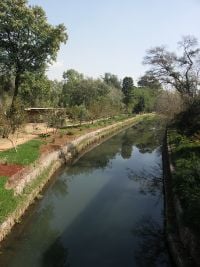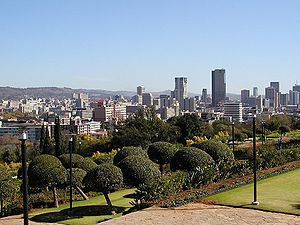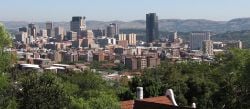Difference between revisions of "Pretoria" - New World Encyclopedia
Mike Butler (talk | contribs) |
Mike Butler (talk | contribs) |
||
| Line 151: | Line 151: | ||
==Economy== | ==Economy== | ||
[[Image:Pretoria_CBD1.jpg|thumb|250px|right|Pretoria CBD, April 2006, from Lukasrand (Muckleneuk Hill), to the SE of the CBD.]] | [[Image:Pretoria_CBD1.jpg|thumb|250px|right|Pretoria CBD, April 2006, from Lukasrand (Muckleneuk Hill), to the SE of the CBD.]] | ||
| − | Pretoria is an important industrial center, with heavy industries including [[iron]] and [[steel]] casting as well as [[automobile]], [[railway]] and [[machinery]] manufacture. In a study entitled ''An Inquiry into Cities and Their Role in Subnational Economic Growth in South Africa'' and published in [[2002]] by statisticians at [[Potchefstroom University]], the city was found to contribute 8.55 | + | The [[Central Business District]] (CBD) of [[Pretoria]], [[South Africa]] is the traditional centre of government and commerce, although today most corporate office, small business, shops and many government departments can be found in the sprawling suburbs of the city rather than the CBD. |
| + | |||
| + | Pretoria is also an important industrial center, with heavy industries including [[iron]] and [[steel]] casting, as well as [[automobile]], [[railway]] and [[machinery]] manufacture, food processing, and diamond mining. | ||
| + | |||
| + | In a study entitled ''An Inquiry into Cities and Their Role in Subnational Economic Growth in South Africa'' and published in [[2002]] by statisticians at [[Potchefstroom University]], the city was found to contribute 8.55 percent of the country's total [[GDP]], making it the third biggest contributor behind [[Johannesburg]] and [[Cape Town]].<ref>[http://www.joburg.org.za/nov_2002/nov25_gdp.stm Joburg and satellites dominate economy]</ref> | ||
Per capita GDP, rank | Per capita GDP, rank | ||
| − | |||
Tourism | Tourism | ||
| − | + | ||
| + | |||
Transport: Road, rail, air, sea | Transport: Road, rail, air, sea | ||
| Line 203: | Line 207: | ||
*[[Loftus Versfeld Stadium|Loftus Versfeld]] | *[[Loftus Versfeld Stadium|Loftus Versfeld]] | ||
| − | |||
| − | |||
| − | |||
| − | |||
| − | |||
| − | |||
| − | |||
| − | |||
| − | |||
| − | |||
| − | |||
| − | |||
| − | |||
| − | |||
| − | |||
| − | |||
| − | |||
| − | |||
| − | |||
| − | |||
| − | |||
| − | |||
| − | |||
| − | |||
| − | |||
==Trivia== | ==Trivia== | ||
Revision as of 22:24, 18 August 2008
| Pretoria | |||
| The central area of Pretoria viewed from the Union Buildings. | |||
|
|||
| Motto: Praestantia Praevaleat Pretoria (May Pretoria Be Pre-eminent In Excellence) | |||
| Country | South Africa | ||
|---|---|---|---|
| Province | Gauteng | ||
| Metropolitan Municipality | Tshwane | ||
| Established | 1855 | ||
| Area | |||
| - Total | 1,644 km² (634.8 sq mi) | ||
| Population (2007) | |||
| - Total | 2,345,908 | ||
| - Density | 856/km² (2,217/sq mi) | ||
| Time zone | SAST (UTC+2) | ||
| Area code(s) | 012 | ||
Pretoria is a city located in the northern part of Gauteng Province, South Africa. It is one of the country's three capital cities, serving as the executive (administrative) and de facto national capital; the others are Cape Town, the legislative capital, and Bloemfontein, the judicial capital.
Pretoria is contained in the City of Tshwane Metropolitan Municipality as one of several constituent former administrations (among which also Centurion and Soshanguve), and therefore sometimes incorrectly referred to as Tshwane — this contentious issue is still being decided.
Geography

Pretoria is the transitional area between the Highveld and the Bushveld, approximately 31 miles (50km) north of Johannesburg in the north-east of South Africa. Pretoria stretches along both sides of the Apies River (also called the Tshwane River), in a warm, well sheltered, fertile valley, surrounded by the hills of the Magaliesberg range, 4495 feet(1370 meters) above sea level.
The city enjoys a dry, sunny climate, with the exception of occasional late afternoon downpours in the summer months of October to April. Temperatures are usually fairly mild thanks to the city's high altitude, with the average maximum daytime temperature in January of 70°F (21.5°C), dropping to an average maximum of around 52°F (11°C) in July. Snow is rare. Mean annual precipitation is 31 inches (784mm).
Pretoria is a well-planned city that covers 635 square miles (1644 square kilometers). Many of the city's streets are lined with jacaranda trees that blossom mauve (purplish blue) in spring, giving rise to the city's nickname "Jacaranda City" (or "Jakarandastad" in Afrikaans).
Pretoria's main street, Church St, which stretches east-west for 12 miles (20km), is the longest urban street in South Africa and one of the longest straight streets in the world.
The levels of smoke and sulphur dioxide have increased in the Pretoria metropolitan area, while lead levels have decreased. Industries, vehicles, veld fires and the burning of coal by households without electricity are the main causes of air pollution, which occasionally rises above acceptable standards in winter.
History
Nguni-speaking settlers, who later became known as the Ndebele (derived from the Sotho word for 'refugees'), were probably the first people to recognise the suitability of the river valley which was to become the location of the future city of Pretoria for settlement.
During the difaqane in Natal, another band of refugees arrived in this area under the leadership of Mzilikazi. However, they were forced to abandon their villages in their flight from a regiment of Zulu raiders in 1832.
Pretoria itself was founded in 1855 by Marthinus Pretorius, a leader of the Voortrekkers, who named it after his father Andries Pretorius. The elder Pretorius had become a national hero of the Voortrekkers after his victory over the Zulus in the Battle of Blood River. Andries Pretorius also negotiated the Sand River Convention (1852), in which Britain acknowledged the independence of the Transvaal. This made him the first successful leader in the fight against British colonialism in Sub-Sahara Africa It became the capital of the South African Republic (ZAR) on 1 May 1860.
The founding of Pretoria as the capital of the South African Republic can be seen as marking the end of the Boers' settlement movements of the Great Trek.
During the First Boer War, the city was besieged by Republican forces in December 1880 and March 1881. The peace treaty which ended the war was signed in Pretoria on 3 August 1881 at the Pretoria Convention.
The Second Boer War (1899 to 1902) resulted in the end of the South African Republic and start of British hegemony in South Africa. During the war, Winston Churchill was imprisoned in the Staats Model School in Pretoria but escaped to Mozambique. The city surrendered to British forces under Frederick Sleigh Roberts, 1st Earl Roberts on 5 June 1900 and the conflict was ended in Pretoria with the signing of the Peace of Vereeniging on 31 May 1902.
The Boer Republics of the ZAR and the Orange Free State were united with the Cape Colony and Natal Colony in 1910 to become the Union of South Africa. Pretoria then became the administrative capital of the whole of South Africa, with Cape Town the legislative capital. Between 1860 and 1994, the city was also the capital of the province of Transvaal, superseding Potchefstroom in that role.
On 14 October 1931, Pretoria achieved official city status. When South Africa became a republic in 1961, Pretoria remained its administrative capital.
After the creation of new municipal structures across South Africa in 2000, the name Tshwane was adopted for the Metropolitan Municipality that includes Pretoria and surrounding towns.
Pretoria previously had a rather sinister image as "the capital of Apartheid South Africa". However, Pretoria's political reputation was changed with the inauguration of Nelson Mandela as the country's first black President at the Union Buildings in the same city. However, the name Pretoria still has a negative connotation to some black South Africans, and therefore a change of name to Tshwane has been proposed. This proposed change is controversial to most of the inhabitants of the city.
One example of the image of Pretoria abroad was the derisive nickname Pretoria-Gasteiz for Vitoria-Gasteiz in Negu Gorriak's song Napartheid.
In 1994 Peter Holmes Maluleka was elected as transitional mayor of Pretoria, until the first democratic election held later that year, making him the first black mayor of this capital of South Africa. Maluleka later became the chairman of the Greater Pretoria Metropolitan City Council (later Tshwane Metro Council), then was elected Speaker of the Tshwane Metro Council and in 2004 was chosen to be a member of the South African Parliament for the Soshanguve constituency.
Government
South Africa is a republic in which the president is both the chief of state and head of government, and is elected by the National Assembly for a five-year term. The bicameral Parliament consists of the National Assembly of 400 members, and the National Council of Provinces of 90 seats.
Pretoria is one of South Africa's three capital cities, serving as the executive (administrative) and de facto national capital. Cape Town is the legislative capital and seat of the National Parliament, as well as the provincial capital of the Western Cape. Bloemfontein is the judicial capital.
In 2000, Pretoria became part of the City of Tshwane Metropolitan Municipality, which is contained in the province of Gauteng. The municipality is made up of 13 former city and town councils and is managed by means of an executive mayoral system.
Gauteng province was formed from part of the old Transvaal province after South Africa's first all-race elections on April 27, 1994.
On May 26, 2005, the South African Geographical Names Council, approved changing the name of Pretoria to Tshwane, which is already the name of the Metropolitan Municipality in which Pretoria, and a number of surrounding towns are located. The name Tshwane is sometimes also used as an alternative name for the city of Pretoria itself, and could become the city's new name if approved by the central government. Should the change take place, "Pretoria" would continue to refer to the city's central business district, as proposed by the current municipality. The proposed name change is controversial. Various public interest groups have warned that the name change will be challenged in court, should the minister approve the renaming.
Economy
The Central Business District (CBD) of Pretoria, South Africa is the traditional centre of government and commerce, although today most corporate office, small business, shops and many government departments can be found in the sprawling suburbs of the city rather than the CBD.
Pretoria is also an important industrial center, with heavy industries including iron and steel casting, as well as automobile, railway and machinery manufacture, food processing, and diamond mining.
In a study entitled An Inquiry into Cities and Their Role in Subnational Economic Growth in South Africa and published in 2002 by statisticians at Potchefstroom University, the city was found to contribute 8.55 percent of the country's total GDP, making it the third biggest contributor behind Johannesburg and Cape Town.[1]
Per capita GDP, rank
Tourism
Transport: Road, rail, air, sea
Demographics
The city had a population of 2,345,908 in 2007. The racial makeup of Gauteng province is Black 73.81 percent, White 19.90 percent, Coloured 3.82 percent, Indian/Asian 2.47 percent.
In the province, 14.4 percent of residents speak Afrikaans at home, 12.5 percent speak English, 1.9 percent speak IsiNdebele, 7.6 percent speak IsiXhosa, 21.5 percent speak IsiZulu, 10.7 percent speak Sepedi, 13.1 percent speak Sesotho, 8.4 percent speak Setswana, 1.4 percent speak SiSwati, 1.7 percent speak Tshivenda, and 5.7 percent speak Xitsonga. 1.0 percent of the population speaks a non-official language at home.
About 76 percent of residents are Christian, 18.4 percent have no religion, 1.7 percent are Muslim, 0.5 percent are Jewish, 0.8 percent are Hindu, while 2.6 percent have other or undetermined beliefs.
Pretoria is one of South Africa's leading academic cities, and it is home to both the largest residential university in the country (the University of Pretoria), the Tshwane University of Technology, and the largest distance education university (the University of South Africa, more commonly known by its initials, UNISA). The South African Council for Scientific and Industrial Research (CSIR) is also located in the city.
Of interest
One of the most popular sports in Pretoria is rugby union. Loftus Versfeld is home to the Blue Bulls who compete in the domestic Currie Cup, the Bulls who compete in the international Super 14 competition (Winners of the Super 14 in 2007) and to soccer side Mamelodi Sundowns . Pretoria also hosted matches during the 1995 Rugby World Cup. Loftus Versfeld will be used for matches of the 2010 Soccer World Cup.There are two soccer teams in the city campaigning in the Premier Soccer League. They are Sundowns and Supersport United. Sundowns are the reigning PSL Champions. Cricket is also popular.
Places of interest
- The National Zoological Gardens of South Africa
- Church Square
- Union Buildings
- Marabastad
- Menlyn Park
Museums
- Kruger House (Residence of the president of the ZAR, Paul Kruger).
- Melrose House (The Treaty of Vereeniging which ended the Anglo-Boer War was signed here in 1902)
- Voortrekker Monument
- Freedom Park
- Transvaal Museum
- African Window
Nature Reserves
- Groenkloof Nature Reserve
- Rietfontein Nature Reserve
- Moreletaspruit Nature Reserve
- Faerie Glen Nature Reserve
- Wonderboom Nature Reserve
- National Botanical Gardens
Stadiums
- Loftus Versfeld
Trivia
- The Cullinan Diamond (the largest gem diamond ever found) was discovered in the town of Cullinan near Pretoria at the Premier Mine on January 26, 1905.
- Pax Praetoriana was named after Pretoria.
- The initial full designation of the city was Pretoria Philadelphia (‘Pretoria of brotherly love’).
- The band Seether is from Pretoria.
See also
- Central Business District of Pretoria.
ReferencesISBN links support NWE through referral fees
- Thompson, Leonard. A History of South Africa, 3rd ed., Yale University Press, 2001. ISBN 0300087764
- Encyclopaedia Britannica Pretoria Retrieved August 18, 2008.
- World Fact Book 2008 South Africa Retrieved August 18, 2008.
External links
- Pretoria name change approved Retrieved August 18, 2008.
- Pretoria portal Retrieved August 18, 2008.
Credits
New World Encyclopedia writers and editors rewrote and completed the Wikipedia article in accordance with New World Encyclopedia standards. This article abides by terms of the Creative Commons CC-by-sa 3.0 License (CC-by-sa), which may be used and disseminated with proper attribution. Credit is due under the terms of this license that can reference both the New World Encyclopedia contributors and the selfless volunteer contributors of the Wikimedia Foundation. To cite this article click here for a list of acceptable citing formats.The history of earlier contributions by wikipedians is accessible to researchers here:
The history of this article since it was imported to New World Encyclopedia:
Note: Some restrictions may apply to use of individual images which are separately licensed.




